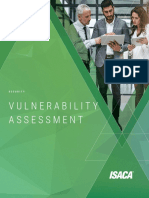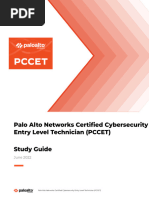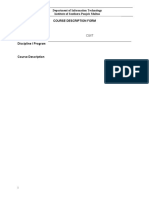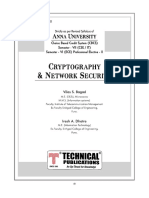0 ratings0% found this document useful (0 votes)
4 views2.MICRO SYLLABUS - PAVT.v3 (VR20)
2.MICRO SYLLABUS - PAVT.v3 (VR20)
Uploaded by
dedipya123Penetration testing syllabus
Copyright:
© All Rights Reserved
Available Formats
Download as DOC, PDF, TXT or read online from Scribd
2.MICRO SYLLABUS - PAVT.v3 (VR20)
2.MICRO SYLLABUS - PAVT.v3 (VR20)
Uploaded by
dedipya1230 ratings0% found this document useful (0 votes)
4 views3 pagesPenetration testing syllabus
Original Title
2.MICRO SYLLABUS -PAVT.v3(VR20)
Copyright
© © All Rights Reserved
Available Formats
DOC, PDF, TXT or read online from Scribd
Share this document
Did you find this document useful?
Is this content inappropriate?
Penetration testing syllabus
Copyright:
© All Rights Reserved
Available Formats
Download as DOC, PDF, TXT or read online from Scribd
Download as doc, pdf, or txt
0 ratings0% found this document useful (0 votes)
4 views3 pages2.MICRO SYLLABUS - PAVT.v3 (VR20)
2.MICRO SYLLABUS - PAVT.v3 (VR20)
Uploaded by
dedipya123Penetration testing syllabus
Copyright:
© All Rights Reserved
Available Formats
Download as DOC, PDF, TXT or read online from Scribd
Download as doc, pdf, or txt
You are on page 1of 3
VELAGAPUDI RAMAKRISHNA
SIDDHARTHA ENGINEERING COLLEGE::VIJAYAWADA
(AUTONOMOUS)
DEPARTMENT OF IT
MICRO LEVEL SYLLABUS
Class Honors Regulation VR20
Subject Code 20ITH6801B Year & Semester III/IV, 6th semester
Title of the Subject PENETRATION TESTING AND VULNERABILITY ASSESSMENT
Unit Content/Topics Covered Text Chapter/ Page
No (mention Sub Topics as found in books) Book Section No. Number
Unit Vulnerability Management Governance [ T1] Chapter 1 6
I Security basics 1.1 7
The CIA triad 1.1.1 7
Confidentiality 1.1.2 8
Integrity 1.1.3 9
Availability 1.1.4 9
Identification 1.1.5 10
Authentication 1.1.6 10
Authorization 1.1.7 11
Auditing 1.1.8 12
Accounting 1.1.9 13
Non–repudiation 1.1.10 14
Vulnerability 1.1.11 14
Threats 1.1.12 14-15
Exposure 1.1.13 15
Risk 1.1.14 15
Safeguards 1.1.15 16
Attack vectors 1.1.16 16
Understanding the need for security assessments 1.2 17
Types of security tests 1.3 17
Security testing 1.4 18-19
Vulnerability assessment versus penetration testing 1.5 19
Security assessment 1.6 20
Security audit 1.7 20-21
Response to some fraud/incident 1.8 22
Safeguarding/protecting critical infrastructures 1.9 23
Bottom-up 1.10 25
Top-down 1.11 25-26
Vulnerability assessment policy template 1.12 27-29
Penetration testing standards 2 30
Penetration testing lifecycle 2.1 30-32
Industry standards 2.2 32
Open Web Application Security Project testing guide 2.2.1 32-33
(OWASP)
Benefits of the framework 2.2.2 33
Penetration testing execution standard (PTES) 2.3 34
Benefits of the framework 2.3.1 34
Unit Security Assessment Prerequisites [T1] Chapter 3 49
II Target scoping and planning 3.1 50-51
Preparing a detailed checklist of test requirements 3.1.1 51-52
Suitable time frame and testing hours 3.1.2 52-53
Identifying stakeholders 3.1.3 53-54
Vulnerability Assessment 3.2 55
Deciding upon the type of vulnerability assessment- 3.2.1 55
Types of vulnerability assessment 3.2.2 55
Types of vulnerability assessment based on the 3.2.3 55-57
location
External vulnerability assessment 3.2.3.1 56
Internal vulnerability assessment 3.2.3.2 57
Based on knowledge about 3.3 57-58
environment/infrastructure(Types)
Black-box testing 3.3.1 58
White-box testing 3.3.2 58
Gray-box testing 3.3.3 58
Announced and unannounced testing 3.4 58
Automated testing 3.5 59-60
Authenticated and unauthenticated scans 3.5.1 59
Agentless and agent-based scans 3.5.2 60
Manual testing 3.5.3 60
Estimating the resources and deliverables 3.6 61-64
Preparing a test plan 3.6.1 63-64
Getting approval and signing NDAs 3.6.2 64
Confidentiality and nondisclosure agreements 3.7 65
Unit Information Gathering [T1] Chapter 4 66
III Introduction 4.1 66-67
Passive information gathering 4.1 67
Reverse IP lookup 4.1.2 68-
Site report 4.1.3 68
Site archive and way-back 4.1.4 69
Site metadata 4.1.5 70
Looking for vulnerable systems using Shodan 4.1.6 71-73
Advanced information gathering using Maltego 4.1.7 74-75
theHarvester 4.1.8 75-76
Active information gathering 4.2 77
Active information gathering with SPARTA 4.2.1 77-79
Recon-ng 4.2.2 80-81
Dmitry 4.2.3 82
Gaining Network Access [T1] Chapter 6 104-
Gaining remote access 6.1 104
Direct access 6.2 105
Target behind router 6.3 105
Cracking passwords 6.4 106
Identifying hashes 6.5 107
Cracking Windows passwords 6.6 108
Unit Assessing Web Application Security [T1] Chapter 7 124
IV Importance of web application security testing 7.1 125
Application profiling 7.2 125-26
Common web application security testing tools 7.3 126
Authentication 7.4 126
Credentials over a secure channel 7.5 127-128
Authentication error messages 7.6 128
Password policy 7.7 129
Business logic flaws- 7.8 137-139
Testing for business logic flaws 7.8.1 138
Auditing and logging. 7.8.2 139
Vulnerability Scoring [T1] Chapter 10 166
Requirements for vulnerability scoring 10.1 166
Vulnerability scoring using CVSS 10.2 167
Exploitability metrics 10.3 168
Attack vector 10.4 168
Attack complexity 10.5 169
Privileges required 10.6 169
User interaction 10.7 170
Scope 10.8 170
Impact metrics 10.9 170
Confidentiality impact 10.9.1 171
Integrity impact 10.9.2 171
Availability impact 10.9.3 171
Report confidence 10.10 173
Text Book:
[T1] Sagar Rahalkar, Network Vulnerability Assessment, Packt, 1st Ed, 2018
Reference Books:
[R1] Andrew Whitaker and Daniel P. Newman, Penetration Testing and Network Defence- The
practical guide to simulating, detecting an responding to network attacks, Cisco Press,
2010.
[R2] Vivek Ramachandran, BackTrack 5 Wireless Penetration Testing, Beginners guide Master
bleeding edge wireless testing techniques with BackTrack 5, PACKT Publishing, 2011.
[R3] Mayor, K.K.Mookey, Jacopo Cervini, Fairuzan Roslan, Kevin Beaver, Metasploit Toolkit
for Penetration Testing, Exploit Development and vulnerability Research, Syngress
publications, Elsevier, 2007.
E-resources and other digital material
[1]. John R Williams, Abel Sanchez , MIT Professional Education, “Cloud DevOps”, 2022
https://professional.mit.edu/course-catalog/cloud-devops-continuous-transformation
[2]. Courseera, “Cloud Application Security”, 2021,
https://www.mooc-list.com/course/cloud-application-security-coursera
[3]. Suresh S, Udemy, “Server Virtualization”, 2021
https://www.udemy.com/tutorial/cloud-computing-the-technical-essentials/basics-of-
virtualization/
[4] Prof.SowmyaKantiGhosh,IITKharagpur, “Cloud Computing”2022
https://nptel.ac.in/courses/106/105/106105167/
Designation Name in Capitals Signature with Date
Course Coordinator Dr.S.SUHASINI
Module Coordinator Dr.S.SUHASINI
Program Coordinator Dr.G.KALYANI
Head of the Department Dr. M.SUNEETHA
You might also like
- Dieter Gollmann-Computer Security-Wiley (2011) - ChínhDocument458 pagesDieter Gollmann-Computer Security-Wiley (2011) - Chính12- Nhật HuyNo ratings yet
- OWASP: Testing Guide v4.2 Checklist: Information Gathering Test NameDocument20 pagesOWASP: Testing Guide v4.2 Checklist: Information Gathering Test NameFerry AstikaNo ratings yet
- Security Risk Management Plan Template 2023Document12 pagesSecurity Risk Management Plan Template 2023naveen100% (2)
- Study of Ethical Hacking: Micro ProjectDocument19 pagesStudy of Ethical Hacking: Micro ProjectRushikesh BhamareNo ratings yet
- Pentest ReportDocument19 pagesPentest ReportMuhammad Awais100% (1)
- Software Security Engineering A Guide For Project PDFDocument6 pagesSoftware Security Engineering A Guide For Project PDFVikram AwotarNo ratings yet
- XBRA3103Document176 pagesXBRA3103Simon Raj100% (2)
- ISACA WP Vulnerability Assessment 1117Document17 pagesISACA WP Vulnerability Assessment 1117Sripal S100% (2)
- Safety Manual HIQuad XDocument84 pagesSafety Manual HIQuad Xgh.rezaazhdariNo ratings yet
- Thank-You For Downloading The Security Risk Management Plan Template!Document11 pagesThank-You For Downloading The Security Risk Management Plan Template!Roqaia AlwanNo ratings yet
- Fundamentalsframworkguidance 131022101806 Phpapp01Document8 pagesFundamentalsframworkguidance 131022101806 Phpapp01mohamedjarray89No ratings yet
- IT Project MNGTDocument66 pagesIT Project MNGTAbhijat ShrivastavaNo ratings yet
- FTDDocument523 pagesFTDmalik jahanNo ratings yet
- Cyber Security AssessmentDocument7 pagesCyber Security Assessmentrifadul islam RiyadNo ratings yet
- Role of Testing in Phases of SDLC and QualityDocument59 pagesRole of Testing in Phases of SDLC and QualityJonathan CarvalhoNo ratings yet
- ICS Security Guide To Hirschmann Switches - Original - 80174Document126 pagesICS Security Guide To Hirschmann Switches - Original - 80174pjl112008No ratings yet
- Hazard Identification and Risk Assessment On Engineering IndustryDocument66 pagesHazard Identification and Risk Assessment On Engineering IndustryMani KandanNo ratings yet
- Certified Tester Specialist: © International Software Testing Qualifications BoardDocument3 pagesCertified Tester Specialist: © International Software Testing Qualifications Boardsrinam89No ratings yet
- rtDocument55 pagesrty22cs094No ratings yet
- Secure and Resilient Software DevelopmentDocument372 pagesSecure and Resilient Software Developmentengr.pawankumar27No ratings yet
- NCC Docker Notary Audit 2015 07 31Document23 pagesNCC Docker Notary Audit 2015 07 31Anupam PoddarNo ratings yet
- Work Zone Safety Manual 2013 NHAI TRIPP PDFDocument199 pagesWork Zone Safety Manual 2013 NHAI TRIPP PDFyuriga9No ratings yet
- Content (KKS)Document3 pagesContent (KKS)Skymoe MoeNo ratings yet
- 1678949516_36Document44 pages1678949516_36hare.krishna.om104No ratings yet
- Virtual Vapt Cert in Certification DatasheetDocument11 pagesVirtual Vapt Cert in Certification DatasheetSANU KUMARNo ratings yet
- Is Notes Full FinalDocument103 pagesIs Notes Full FinaljesudosssNo ratings yet
- Ifeg Imp PDFDocument11 pagesIfeg Imp PDFvarun workNo ratings yet
- Anonymized Web Application Penetration Testing ReportDocument54 pagesAnonymized Web Application Penetration Testing ReportSanto RabidasNo ratings yet
- RAMS and VV FundamentalsDocument46 pagesRAMS and VV Fundamentalsravi kumarNo ratings yet
- Full Download Enterprise Information Security and Privacy 1st Edition Warren C. Axelrod PDF DOCXDocument75 pagesFull Download Enterprise Information Security and Privacy 1st Edition Warren C. Axelrod PDF DOCXtorilkilde100% (8)
- AndroidDocument13 pagesAndroidkaran kisnaniNo ratings yet
- Sample Cloud Security ProjectDocument12 pagesSample Cloud Security ProjectKhairul AnamNo ratings yet
- Penetration Testing Reportmars 14, 2022: Prepared By: Email: TelephoneDocument19 pagesPenetration Testing Reportmars 14, 2022: Prepared By: Email: TelephoneEmma ma100% (1)
- Foundations of Software Testing 2nd Edition 9788131794760 9789332517653 8131794768 9789332517660 9332517665 - CompressDocument728 pagesFoundations of Software Testing 2nd Edition 9788131794760 9789332517653 8131794768 9789332517660 9332517665 - CompressKishan DhageNo ratings yet
- Predicting Software Assurance Using Quality and Reliability MeasuresDocument59 pagesPredicting Software Assurance Using Quality and Reliability MeasuresRakesh KhannaNo ratings yet
- Chapter 3.2022.englishDocument59 pagesChapter 3.2022.englishcamnhu622003No ratings yet
- Computer-Security-Third-Edition-Dieter-Gollmann 2Document30 pagesComputer-Security-Third-Edition-Dieter-Gollmann 2jeff rer100% (2)
- GL Cyber Security 202007e PDFDocument64 pagesGL Cyber Security 202007e PDFsupervision-810446No ratings yet
- Test PlanDocument21 pagesTest PlanSatish RacherlaNo ratings yet
- Example-Pentest-ReportDocument90 pagesExample-Pentest-ReportjmonroytemuNo ratings yet
- Risk Management Mapping Sheet Dee45655 9757 44b8 A77a 138fd8150f6bDocument11 pagesRisk Management Mapping Sheet Dee45655 9757 44b8 A77a 138fd8150f6bTarun VenkateshNo ratings yet
- CPNI OR FrameworkDocument52 pagesCPNI OR FrameworkIzet MahirNo ratings yet
- VSS Standard For BuildingsDocument28 pagesVSS Standard For Buildingsdanielcs_shiNo ratings yet
- Curriculum of Competency Unit (Cocu)Document21 pagesCurriculum of Competency Unit (Cocu)Syah RiezalNo ratings yet
- WEBSITE SECURITY ASSESSMENT PrasadDocument35 pagesWEBSITE SECURITY ASSESSMENT PrasadPrasad More 64No ratings yet
- Blocksec Alpaca v1.0 SignedDocument14 pagesBlocksec Alpaca v1.0 Signedcedobaw359No ratings yet
- IT Audit QuestionnaireDocument126 pagesIT Audit QuestionnaireLakshmi Priya100% (1)
- Blocksec Arken V1.0-SignedDocument11 pagesBlocksec Arken V1.0-Signedcedobaw359No ratings yet
- TestingDocument83 pagesTestingapi-3856328No ratings yet
- DLF Final - Fsa Esa - Renew Power - Common Area & Building FloorsDocument48 pagesDLF Final - Fsa Esa - Renew Power - Common Area & Building FloorsVivek AgarwalNo ratings yet
- Blocksec Cakepie V1.0-SignedDocument11 pagesBlocksec Cakepie V1.0-Signedcedobaw359No ratings yet
- Cyber Security ReportDocument62 pagesCyber Security Reportshanmukareddy.gudimetlaNo ratings yet
- Pccet Study GuideDocument221 pagesPccet Study GuideBharath RamNo ratings yet
- Marine Oil Spill ResponseDocument54 pagesMarine Oil Spill ResponseMOHAMEDNo ratings yet
- BK-ACCESSB Operator Manual (2000-03 Rev 101732K) Pp264-OCRDocument264 pagesBK-ACCESSB Operator Manual (2000-03 Rev 101732K) Pp264-OCRАлексейNo ratings yet
- Acknowledgement: Somshekhar (4KM13LDE08)Document5 pagesAcknowledgement: Somshekhar (4KM13LDE08)Venkatesh NANo ratings yet
- Web Application VA_PT First Report_SampleDocument14 pagesWeb Application VA_PT First Report_SampleNeeraj singhNo ratings yet
- 1.Security By Design and Risk Management (Day 1) - 2022 - StudentDocument68 pages1.Security By Design and Risk Management (Day 1) - 2022 - StudentPoh Hong YitNo ratings yet
- How To Apply Risk Based Thinking EbookDocument70 pagesHow To Apply Risk Based Thinking EbookNiezel Sabrido100% (1)
- Guidelines for Developing Quantitative Safety Risk CriteriaFrom EverandGuidelines for Developing Quantitative Safety Risk CriteriaNo ratings yet
- Guidelines for Chemical Transportation Safety, Security, and Risk ManagementFrom EverandGuidelines for Chemical Transportation Safety, Security, and Risk ManagementNo ratings yet
- Security Principles: 27/sp800-27 PDFDocument2 pagesSecurity Principles: 27/sp800-27 PDFMichael Mark Deompoc TimoteoNo ratings yet
- Unit 3 - Threat ModellingDocument13 pagesUnit 3 - Threat ModellingNivedhithaNo ratings yet
- PR 10Document9 pagesPR 10jivanlad22No ratings yet
- Course Plan Information SecurityDocument7 pagesCourse Plan Information SecurityMalik KashifNo ratings yet
- Glosario de Terminologia PCI DSS v3.2Document22 pagesGlosario de Terminologia PCI DSS v3.2Angel CarrilloNo ratings yet
- Information Security, Theory and Practice. Lecture 10: MalwareDocument44 pagesInformation Security, Theory and Practice. Lecture 10: Malwareeugene_yang1726No ratings yet
- Lab Project Portfolio ReportDocument29 pagesLab Project Portfolio Report612456No ratings yet
- Secure Lock Manager Easy Quick Start GuideDocument61 pagesSecure Lock Manager Easy Quick Start GuideEd ArenasNo ratings yet
- Threat Intelligence Glossary 1Document3 pagesThreat Intelligence Glossary 1rNo ratings yet
- Browser in The Browser Attacks A Devastating New Phishing Technique ArisesDocument6 pagesBrowser in The Browser Attacks A Devastating New Phishing Technique ArisesLawrence LauNo ratings yet
- SoftwareAGRansomware AttackDocument4 pagesSoftwareAGRansomware Attackhuma tariqNo ratings yet
- Business Iot Targeted by Espionage Groups Tda Cyber SnapshotDocument6 pagesBusiness Iot Targeted by Espionage Groups Tda Cyber SnapshottonykwannNo ratings yet
- The German eID-Card by Jens BenderDocument42 pagesThe German eID-Card by Jens BenderPoomjit SirawongprasertNo ratings yet
- 8 Step To Remove W32salityaeDocument188 pages8 Step To Remove W32salityaeMilosav Pusonjic MikiNo ratings yet
- User Authentication and Single Sign On PDFDocument119 pagesUser Authentication and Single Sign On PDFravibabu1620No ratings yet
- Ciampa - SecurityAwareness6e - PPT - Module02 - TaggedDocument60 pagesCiampa - SecurityAwareness6e - PPT - Module02 - TaggedwbysnjxqwgNo ratings yet
- Cybercrime Computer Crime, PrivacyDocument12 pagesCybercrime Computer Crime, Privacymuhooziowen85No ratings yet
- EC Council Ehtical Hacking and Contermeasures (CEH) v6Document130 pagesEC Council Ehtical Hacking and Contermeasures (CEH) v6Adam Dhori'unNo ratings yet
- Burpsuite Essential Content 2Document6 pagesBurpsuite Essential Content 2Aaron Prey100% (1)
- ICT - AuthenticationDocument1 pageICT - AuthenticationAmirul ZackNo ratings yet
- Endpoint Select Datasheet PDFDocument4 pagesEndpoint Select Datasheet PDFOnsite-it PKNo ratings yet
- Technical Seminar Doc (Rupesh)Document24 pagesTechnical Seminar Doc (Rupesh)nphotographer99No ratings yet
- CS8792 Cryptography & Network SecurityDocument331 pagesCS8792 Cryptography & Network SecurityBalaji VNo ratings yet
- Vulnerability Scanning 101 White PaperDocument15 pagesVulnerability Scanning 101 White PaperJohn DoeNo ratings yet
- EY - Protecting Your Data PDFDocument8 pagesEY - Protecting Your Data PDFlateshv2728No ratings yet
- 006 Course Guide - Bug Bounty & Web Security by ZTMDocument5 pages006 Course Guide - Bug Bounty & Web Security by ZTMDarshan ChindarkarNo ratings yet
- Clave para AntivirusDocument19 pagesClave para AntivirusTAMARITANo ratings yet
- NotesDocument3 pagesNotesRoritoGamingsNo ratings yet

























































































